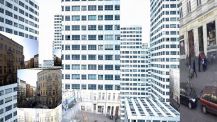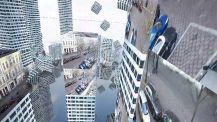360° Mobile VR App
Nonplace – the Age of the Anthropocene explores the relationship between humans and nature in the Anthropocene era. Humans have become one of the most important factors influencing the biological, geological and atmospheric processes on Earth [1]. The 360° New Media Art Mobile VR App Nonplace – the Age of the Anthropocene points to the loss of identities through technological progress and globalization and poses the question of what the ever-growing similarity of cities, shopping centres and commodities means.
With Nonplace – the Age of the Anthropocene you fly through an endless futuristic city and individualise the high-rise buildings with your images. The high-rise buildings all look the same and form an endless city, in which there are no differences. Flying through the city, you project individual images onto the high-rise buildings, which are automatically captured with the camera from your surroundings. That’s how you shape the city with identity. But this decays again, continuously.
Nonplace rendered visually and conceptually into Virtual Reality what Marc Augé describes in his book and essay ‘Non-places’. According to Augé: “Super modernity produces non-places, meaning spaces which are not themselves anthropological spaces and which do not integrate to earlier places (…) A world where people are born in the clinic and die in hospital, where transit points and temporary abodes are proliferating under luxurious or inhuman conditions (hotel chains and squats, holiday clubs and refugee camps, (…); where a dense network of means of transport which are also inhabited spaces is developing; where the habitué of communicates wordlessly, through gestures, with an abstract, unmediated commerce (i.e. credit card transactions); a world thus surrounded by solitary individuality”.[2]
References
- ↑Edwards, Lucy E. “What is the Anthropocene?”, 2015
- ↑Marc Augé, Non-Places: An Introduction to Anthropology of Supermodernity, Le Seuil, 1992



